AWARD in Memorial Tourney
"Viktor Kolpakov - 55"
Published: 08.03.2011 |  | | 29.11.1955 - 02.03.2001 |
First of all I would like to thank the all participants for their entries. The tourney has happened to be interesting and numerous. 127 problems (69 h#2 and 58 h#3) were received for judging from 58 authors from Azerbaijan, Belarus, Czech Republic, Finland, France, Germany, Hungary, Israel, Italy, Lithuania, Mongolia, Poland, Russia, Serbia, Slovakia, Sweden, Switzerland, Ukraine and USA.
In both sections themes are free. Zerpositions were allowed but no promoted or fairy pieces were required.
The report contents direct links to the chess problem database server http://www.softdecc.com/pdb/index.jsp
Competing chess problems with uninteresting play and obvious defects (such as unmatched play of both sides in phases, unnecessary repetition of moves, idle white officers in mate positions, unsatisfactory construction or twinning form, evident symmetry in play) were excluded from awarding.
Besides that the following problems were excluded from the award:
- E. Abdullaev (Kå6-Kb6). There are idle white officers in solutions plus strongly anticipated: P0521005 I. Tominic, Mat, 1975, 1 Pr (W:Kh6 Rb3,b5 Sd3,d5 Pc5 B:Kc4 Qe2 Ra2,g5 Ba4,f4 Se4 Pa5,c6,c7,d2,e3; h#2 4.1..).
- V. Aberman (Kå8-Kå5). Unsatisfactory twinning form in miniature, in addition partially anticipated: P1071119 J. Markov, Ideal-Mate Review, 2000 (W:Ke7 Pf2,g2 B:Kf5 Qd5 Se5 Pg5; h#3 'b' Se5->f3).
- I. Antipin (Kb8-Kå4). Anticipated: P1182316 V. Medintsev, Springaren, 2009 (W: Kñ6 Bà4,f8 Pd5,f2 B:Kf3 Be1,g2 Pf4,g3; h#2 2.2.1.1.).
- I. Antipin (Kd2-Kå6). Similar idea has been already shown with best asymmetry of play: P0579666 G. Chumakov, Suomen Tehtavaniekat, 1995 (W:Kå4 Sñ7 Pd4 B:Kå7 Rd7,f7 Bh8; h#3 2.1..).
- A. Vilkauskas (Kh1-Kd5). Anticipated: P0547067 T. Garai, Mat 1987 2 Pr (w:Kà3 Bå3 Sf3 Pñ2,d2,d5 B:Kf5 Qf8 Rf6,h3 Be4,e7 Sg8,h4 Pc4,d6,e5,f7,h6; h#3 2.1..); see also P0575324.
- H. Grubert (Kñ8-Kà5). Anticipated: P0507556 I. Soroka, R. Fedorovich, Europe Echecs, 1987, 3 HM (W:Kñ7 Bh5,h8 Pñ2 B:Kñ4 Rb1,h2 Ba3,h1 Pb7,e2,h3; h#2 2.1..).
- K. Drazkowski (Kh2-Kc4). In my opinion, an unsuccessful attempt to improve author's own older work P0521834: idle wB in 'd' twin. Besides white AUW in miniature has been shown many times (see e.g. P0508146).
- C. Jonsson (Ka8-Ke6). In my view, 2nd pair of solutions is added mechanically (bQd2 & wPsf2,h3 are unneeded in 1st pair) plus not quite matched play.
- A. Kirichenko (Kg8-Kg5). Anticipated: P0515361 E. Holladay, Ideal-Mate Review, 1983 (W:Kb1 Sb5 B:Kb3 Rb4,b7; h#3 2.1..).
- J. Csak (Kf8-Kf4). Three half-moves from four are repeated in 2nd pair of solutions; the play in 1st pair is known (see P0539551).
- V. Mateush (Kå2-Kg5). Anticipated: P1080024 N. Parhomenko, Chess Leopolis, 2008 (W:Kf1 Re8,h7 B:Kf6 Pg6,g7; h#2*).
- V. Mateush (Kd3-Ka8). Anticipated: P1185242 T. Lehmann, Sachova Skladba, 1999 (W:Kb2, Qc3 B:Kd8, Qe5, Rc6, Bh8, Pd7; h#2 2.1..).
- V. Nefyodov (Ke1-Kf5). An attempt of improvement of A. Oshevnev's problem P1089246 is unsuccessful in my view. Besides the similar idea has been realized in best construction (see P0550758, P1182337).
- A. Nikolichev (Kf5-Kd6). There is a promoted black bishop in 'b' twin position, that is not allowed in the tourney conditions.
- A. Onkoud (Kh8-Ke4). Anticipated: P1185243 A. Molnar, Sakkelet, 1994 (W:Kh4,Sc4,e7, Pd6 B:Ke6, Qg8, Ra6,f5, Bd8, Sd5,d7, Pc5,c7,f7,g6,g7 h#2 5.1..).
- E, Orlov, Y. Gordian, G. Chumakov (Kg8-Kd3). Anticipated: P1182319 V. Medintsev, Variantim, 2007 (W:Kb3 Qh4 Ra5,d4 Bg3 Pb4,c3,d2 B:Kå6 Rñ2,ñ8 Bñ6 Så8,g8 Pa6,b7,f5,f6,g6,g7,h5; h#2 2.1..), see also P0577905.
- A. Pankratyev (Kb8-Kñ4). Anticipated: P1093127 V. Abrosimov, E. Zarubin, Zadachi i etjudi, 2009 (W:Ke8 Rå7 Bñ7 Sd6,e6 Pb5,c4,g5 B:Kå5 Qà5 Rà7,g7 Bh8 Sg4,g8 Pb6,f7; h#2 6.1..).
- A. Pankratyev, M. Gershinsky (Kb7-Kñ3). Anticipated: P0526353 C. Goumondy, Skakbladet 1986 (W:Kd8 Rñ6,f4 Bf7 Sg5 Pc5,d2,d6 B:Kñ4 Qd4 Rà7,d5 Bh4 Sñ8 Pb4,c3,d3,f2,f5; h#2 b)Pb4->b3); see also P0547881.
- A. Pankratyev (Kf3-Kñ5). Anticipated: P0527825 J. Bogdanov, V. Vladimirov, Probleemblad 1988, 1 Pr (W:Kf3 Rg2 Bd1,g3 Pa3,b3,e2,f4 B:Kñ3 Qd8 Rd7,h3 Be7,h1 Sg8 Pb2,c5,d2,e3,f6,h2,h4,h5; h#2 2.1..).
- V. Syzonenko (Kå1-Kå5). The similar "line-knight mechanism", as it calls by the author, has been successfully realized by himself (1 Pr, Warsaw Solving Grand Prix, 2010).
- K. Solja (Kb5-Ke5). Idle wRà5 in two of four solutions, additionally anticipated: P0521005 I. Tominic, Mat, 1975, 1 Pr (W:Kh6 Rb3,b5 Sd3,d5 Pc5 B:Kc4 Qe2 Ra2,g5 Ba4,f4 Se4 Pa5,c6,c7,d2,e3; h#2 4.1..).
- A. Stjopochkin (Kb7-Kd3). Anticipated: P0507786 B. Ostruh, Springaren 1979 (W:Kd6 Qb2 B:Kå8 Qñ1 Rb1,g3 Ba1,h3 Pa5,b4,c2,c3,c4,f3,f7,g2; h#2 2.1..)
- A. Stjopochkin (Kh5-Kf6). Too mechanical play with repeated B2 in pairs of solutions.
- A. Stjopochkin (Kc8-Kg4). Rather homogeneous and interesting play but the problem is not presents itself something the whole (phases are joined mechanically and look like two disconnected parts).
- V. Chernyh (Kñ1-Kà8). Anticipated: P0554188 C. Sabadini, Bilten, 1964 (W:Kf5 Rà7 Bà1 B:Kb6 Qb2 Bb8 Pà6; h#3 b) Kb6->a2)
- S. Shumeiko (Kh1-Ke6). Anticipated: P0547218 J. Knippel, Tidskrift fur Schack, 1939 (W:Kå1 Rd3 Bf4 B:Kd6 Rñ8 Bd5 Sñ6,å5; h#3*).
- C. Jakubovsky (Kg8-Kd6). An idea has been shown many times in best construction (see e.g. P1005599).
Award is the following. Helpmates in 2 moves
1st Prize
Vladimir Klipachev (Russia) |
a) diagram 1.Rd4 g4+ 2.Ke5 Sc4 #
b) Pg2->c4 1.Qe7 c5 2.K:e6 Bc8 #
c) Pg2->h6 1.Qd4 B:e4+ 2.Kf6 Sd7 #
d) Pg2->f2 1.R:e6 Sd5 2.Ke4 S:e3 #
Rich in content problem with self-pinning of bRe4 & bQ at two lines, reciprocally changed functions of Sb6/Bb7 and Bñ3/Rå8, Umnov effects and pin-mates on four different squares in twin form (compare with P1182617). Captures of black pieces in ñ) and d) twins are a little unpleasant. |  | | h#2 see text (7+8) |
2nd Prize
Abdelaziz Onkoud (France) |
1) 1.gf6 Be5(A) 2.K:c6 Be4(Â) #
2) 1.gf5 Rd6+ 2.Ke4 Rd4 #
3) 1.S:f6 Be4(Â)+ 2.Kd6 Be5(A) #
4) 1.B:c3 Bd3 2.Kd4 Rd6 #
An unusual realization of doubled Zilahi, reciprocal change of W1/W2 and model mates on four different squares in multi-solution form. Repetition of move Rd6 detracts. | 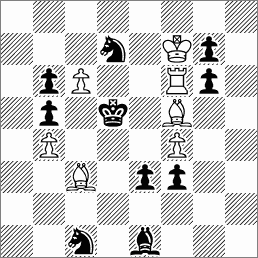 | | h#2 4.1.. (7+10) |
Prize for miniature
Anatoly Stjopochkin (Russia) |
1) 1.Qc4 Qh6 2.Kg8 B:c4 #
2) 1.Qb5 Qf6+ 2.Ke8 B:b5 #
3) 1.Qe6 Bb5 2.Be7 Be8 #
4) 1.Qf5 Be2 2.Kg6 Bh5 #
HOTF-type idea is shown in multi-solution form with two pairs of model echo mates connected by fourfold direct unpinning of mating wB. The miniature could be flawless if not repeated move Bb5. | 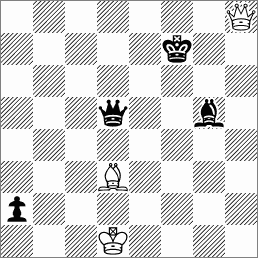 | | h#2 4.1.. (3+4) |
1st Honorable Mention
Sven Trommler (Germany) |
a) diagram
1.Rd5 f7 2.Re5Sf6 #
1.Bb2 cb6 2.Be5 Sdc5 #
b) Pb6->d4
1.Rf1 g6 2.Rf4 Sg5 #
1.Bc1 c6 2.Bf4 Sec5 #
Two pairs of thematically connected solutions with active self-block of squares å5 & f4 by bB/bR, Umnov effect in white play and four mates by both wSs, involving mates on the same square. The idea is rather simple but has realized in a masterful fashion! Meredith without technical units.
| 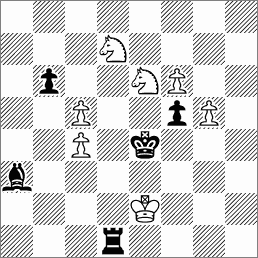 | | h#2 2.1.. b) Pb6->d4 (7+5) |
2nd Honorable Mention
Aleksandr Semenenko (Ukraine) |
a) diagram
1.Qg5 Rb1 2.Qe3 Rb4#
1.S:e6 Sd8 2.Sc4 S:e6#
b) Df6<->Se5
1.Qc7 Êd6 2.Q:c5 Re4#
1.Sg4 Rf1 2.Se3 Rf4#
By the use of conceptual twinning the author has joined two known half-pin mechanisms (see P1112818, P0538959) and has shown four pin-mates in center of the board. But the phase with mate by wS is not correspond strongly to general content of the problem.
| 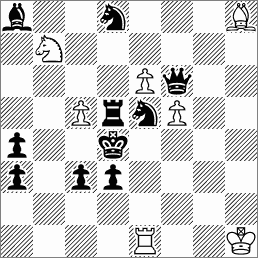 | | h#2 2.1.. b) Qf6<->Se5 (7+10) |
3rd Honorable Mention
Sergey Shumeiko (Russia) |
1) 1.Ka6 cb7 2.Sb5(A) b8=S #
1. ... Bg4 2.b5(B) Bc8 #
2) 1.Kc4 B:h5 2.Sb5(A) B:f7 #
1. ... Kf5 2.b5(B) d3 #
3) 1.Ka4 B:d1 2.Sb5(A) c3 #
1. ... Bd5 2.b5(B) Bb3 #
An unusual problem in Onitsiu form with six different mates. Repetition of B2 in variants is according to scheme but hardly is an achievement. Nevertheless I could not find any problem with similar stipulation which not contents repeated moves of both sides (see e.g. P0542239, P0504640).
| 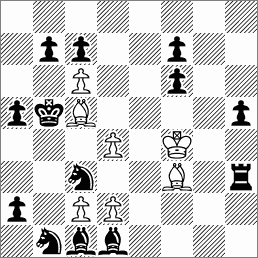 | | h#2 3.2.1.1. (7+13) |
4th Honorable Mention
Abdelaziz Onkoud (France) |
1) 1.Qa7 Sg1! 2.Q:g1 Bf3 #
2) 1.Qd3 Sf1 2.Q:f1 Rh2 #
In a light construction is shown an idea that not easy to realize: quiet (without check and capture) active sacrifice of a white piece which is captured at B2 by black officer (not by bK or bP). Compare with P1183415. Plus reciprocally changed functions of Sf3/Sh2 & Bg4/Rh4 and Umnov effects in the play of White. It is a pity that only one solution contents a false manoeuvre (1. ... Sd4?).
| 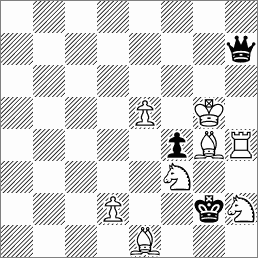 | | h#2 2.1.. (8+3) |
5th Honorable Mention
Andreas Schoenholzer
(Switzerland) |
1) 1.Sg:e3 Kd6 (Kf6?) 2.Sd5 Sf3 #
2) 1.B:e3 Kf6 (Kd6?) 2.Bc5 Sc4 #
To activate indirect white half-battery the Black has to annihilate wPe3 and then to interfere a black line-piece with line-opening (cutting-in of wRe8). Doing that an interesting nuance occurs: B1 determines an alternative W1, motivated by direct check avoidance to wK at B2. Attractive Meredith with pleasant dual avoidance.
|  | | h#2 2.1.. (6+6) |
6th Honorable Mention
Valery Semenenko (Ukraine) |
1) 1.Bg5 Qe1(Qa4?) 2.cd4 R:d4 #
2) 1.Bf5 Qa4(Qå1?) 2.cb4 Bf6 #
A new tactical interpretation of known idea (see P1005171, P1006812). Alternative anticipatory interference of bRh5 (motivated by indirect check avoidance to wK at B2) determines the anti-dual choice of W1, with further line-opening by capturing of a white piece (involving passive Zilahi). Meredith with diagonal/orthogonal model mates. There is a slight discord at B2: the motive of capturing wBd4 is not only line-opening (cutting-in of wRc2) but is a square vacation (block annihilation), too.
| 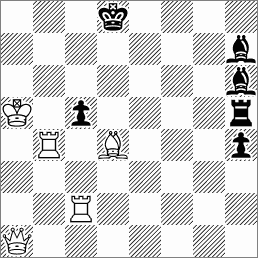 | | h#2 2.1.. (5+6) |
7th Honorable Mention
Zoltan Labai (Slovakia) |
1) 1.cd4 B:d4 (S:d4?) 2.Sd3b3 #
2) 1.R:d4 S:d4 (B:d4?) 2.Bd3 Bb3 #
Alternative sacrifice of a black piece at B1 determines W1, plus active self-blocks of d3 square by different black pieces with bRf3 interference. Reciprocal change of functions between Rd5/Pñ5, Sf5/Bg1 and Bà4/Pb2 with model mates by different white pieces on the same square. Slight imbalance at B2 is quite acceptable. Partial anticipation with identical play of White has not allowed to rank this problem higher (see P1183086).
| 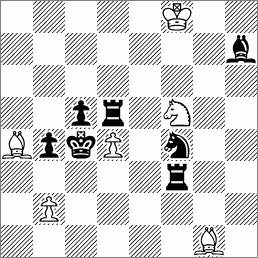 | | h#2 2.1.. (6+7) |
8th Honorable Mention
Vasily Mateush (Russia) |
a) diagram 1.Re3 Qd5 2.Rg3 Ra4 #
b) Kg4->f5 1.Rf4 Qc6 2.Qg4 Ra5 #
c) Kg4->e6 1.Re5 Qb7 2.Qf5 Ra6 #
Three model echo mates in elegant aristocratic position with systematic movement of the white pieces. But tactics is weak: gate-opening and self-blocks. Besides twinning form is rather radical but as one could see, that is the only way to realize the idea. As a whole the problem produces a pleasant impression.
| 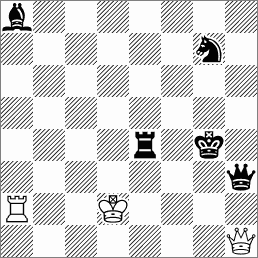 | | h#2 b),c)Kg4->f5,e6 (3+5) |
Honorable Mention for task
Semion Shifrin (Israel) | a) wPf2 1. S:b3 Rf7 2. Sd2 Sc3 #
b) Sb2->f5 1. B:d5 Rd7 2. Bf3 Bc4 #
c) Bb3->a4 1. R:d5 Bc6 2. Rd2 Re7 #
d) Sa1->h7 1. R:b3 Rc7 2. Rf3 Rc2 #
e)=d) Rg7->g5 1. S:g5 Sc4 2. Sf3 Sf4 #
f)=e) Bb3->a6 1. B:g5 Bc8 2. Bd2 B:g4 #
The most ambitious problem of the section: doubled triple cyclic Zilahi in combination with self-block of the same square by different black pieces (see P0583483). It is notable that captures, self-blocks and mates do pieces of the same type (in each phase). Considering complexity of content I find heavy twinning form acceptable though there are examples of similar record problems with best one (see e.g. P1078890). | 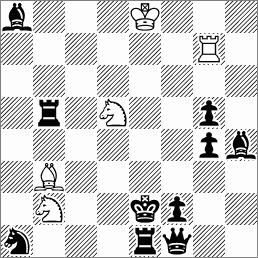 | | h#2 zero, see text (5+10) |
1st Commendation
Jevgeny Fomichev (Russia) | a) diagram 1.R:f2+ (B:g2, Q:g4?) K:f2
2.Be5 (Êe5, Re5?) Se3 #
b) Bf4->d4 1.B:g2+ (Q:g4, R:f2?) K:g2
2.Êe5 (Re5, Be5?) R:d4 #
c) Pb4<->Pg5 1.Q:g4+ (R:f2, B:g2?) K:g4
2.Re5 (Be5, Êe5?) S:f4 #
To reach a goal the Black must capture one of the three initially pinned white pieces to vacate a free square for wK and to unpin the rest thematic white pieces by that way. B1 and B2 have realized as a choice of three thematic moves. It is a great pity that cyclic Zilahi has not turned out. Besides the play of both sides in phases is not quite homogeneous (tactically). Twinning form is not good but acceptable. These flaws together with partial anticipation (see P1005127) have defined a place of the problem. | 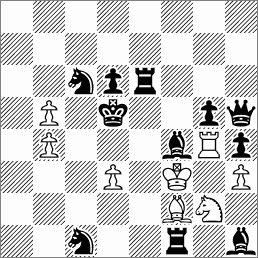 | | h#2 see text (8+11) |
2nd Commendation
Sven Trommler (Germany) |
a) diagram 1.Rc5 Ba4 2.d5(c) Se5(a) #
b) Bc2->e4 1.Rb5 Sf4 2.c5(b) Bd5(c) #
c) Sd4->e6 1.Sf8 gf8=Q 2.e5(a) Qc5(b) #
A cycle of squares on which the Black and the White play at its 2nd move is presented in Meredith position - not easy to realize. But the play in c) twin is absolutely not correspond (tactically) to that one in the rest phases.
|  | | h#2 see text (4+8) |
3rd Commendation
Ivan Antipin (Russia) |
a) diagram 1.Kc3 Rb1 2.Be2 Se4 #
b) wRa6 1.Kd5 Bh2 2.Rc7 Rd6 #
A nice aristocratic Meredith with interesting but not quite harmonious play. The idea of black play is known (see P0539551).
| 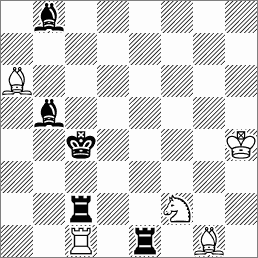 | | h#2 b)wRa6 (5+5) |
4th Commendation
Zoltan Labai (Slovakia) |
1) 1.Qc2 Sb3 2.Kd3 Sd2 #
2) 1.Kf3 Sc2 2.Qe3 Se1 #
Two model pin-mates with short bQ Pelle move in light construction. There is a lack of analogy in the play of both sides.
| 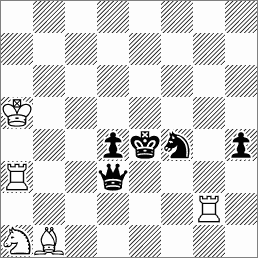 | | h#2 2.1.. (5+5) |
5th Commendation
Aleksandr Pankratyev (Russia) |
1) 1.f5 Sc3 2.Sf6 Se5 #
2) 1.c6 Sf4 2.Rc7 Sd6 #
Rather simple but homogeneous play ending with model mates on squares which are initially guarded thrice by the Black. The problem has a lack of unity: the play of Black is absolutely disconnected between solutions. Compare with P1075173.
|  | | h#2 2.1.. (4+10) |
6th Commendation
Vasily Chernyh (Russia) |
1) 1.Rd2 Sf4 2.Rd4 Sg6 #
2) 1.Ra6 Bb4 2.Rd6 Bc3 #
Perfectly-constructed Meredith with direct unpinning of mating white piece, active self-block, reciprocally changed functions of Sh3/Bå7 and model mates in center of the board (compare with P0571431).
|  | | h#2 2.1.. (5+3) |
Commendation for miniature
Vadim Vinokurov (Russia)
author's version |
a) diagram 1.Sg3 Rd4 2.Se2 Rd1 #
b) Pg2->e2 1.Sd2 Rc4 2.Ke1 Rc1 #
c) Pf2->h2 1.Sf2 Re4 2.Kg1 Re1 #
Minimal super miniature with three chameleon-echo model mates and active self-block with gate-opening (in 'a' & 'b' twins; Umnov effect - in 'c').
Original position: 8/8/8/8/5p1p/6kP/5n1R/6K1 b)Pf4->e4, c)Kg1->f1.
| 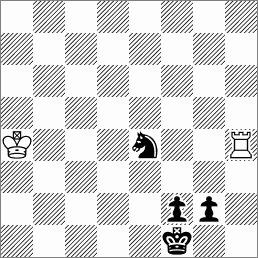 | | h#2 see text (2+4) |
Helpmates in 3 moves
1st Prize
Dieter Muller, Rolf Wiehagen
(Germany) |
1) 1.Qc2 B:e2+ 2.K:e2 Rd8 3.Kd1 Sc3 #
2) 1.Êd3 R:e4 2.K:e4 Bb7 3.Rf4 Sf6 #
An excellent strategical problem with distant blocking and gate-opening at B1, active sacrifice of a white officer (motivated by square vacation for bK) at W1, white battery creation by ambush move of a rear piece, reciprocally changed functions of Rå8/Bà6 and battery mates in well-constructed position without technical units. Imbalanced B3 is a forced shortcoming.
| 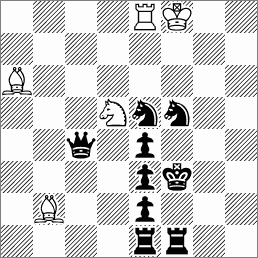 | | h#3 2.1.. (5+9) |
2nd Prize
Abdelaziz Onkoud (France) |
1) 1.gf4 Sc4 2.Bf6 ef6 3.Se3 S(e)e5 #
2) 1.de3 Sg6 2.Rd6 ed6 3.Sf4 S(f)e5 #
An original strategic combination with capture of a white piece (involving passive Zilahi) motivated by gate-opening for a black piece with its further sacrifice, Umnov effect in white play and delayed Umnov at B3 plus model mates on the same square. Construction is heavy but seems optimal for present content. It is a little bit pity that only one solution contents a false manoeuvre (1. ... Sd3?).
| 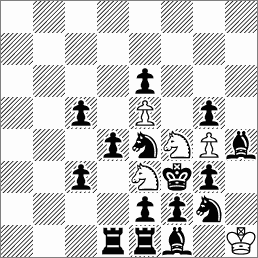 | | h#3 2.1.. (5+15) |
3rd Prize
N. Kolesnik, V. Semenenko
(Ukraine) |
a) 1.Kd4+ Rb7(À) 2.Bb2 Sg2(Â) 3.Bc3 Rd7 #
b) 1.Ke6+ Sg2(Â) 2.Re1 Rb7(À) 3.Re5 Sf4 #
An ingenious modernization of known idea (see P1072969, P1003091). Creation and play of white half-pin with reciprocal change of moves (W1/W2) and reciprocally changed functions of Rb2/Så1. The sequence of W1-W2 in phases is conditioned by the need to vacate a square initially occupied with a white piece for blocking black piece with Umnov effect at B2. Model mates and good construction. It is a pity that wPd3 is needed only in a).
| 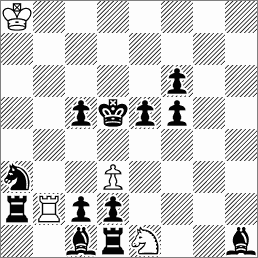 | | h#3 b)Pe5->d6 (4+12) |
4th Prize
Antanas Vilkauskas (Lithuania) |
a) 1.Rg4 Rb5!(A) 2.Qc2 R:c5+ 3.Se5 B:c2(B) #
b) 1.Rg6 Bc2!(B) 2.Bb5 B:d3+ 3.Se4 R:b5(A) #
Another good example showing how one could enrich the tactics content in known pin-transformation mechanism (see P0506194). Harmonious problem with self-block and gate-opening, W1 tempo move, reciprocal change of W1/W3 and reciprocally changed functions of Rà5/Bb1, indirect unpinning, pin-transformation and diagonal/orthogonal model pin-mates. Technical wPs is a forced step which has justified by the rich play.
| 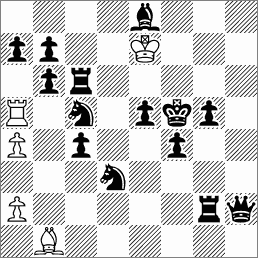 | | h#3 b) Pg5->g4 (5+14) |
5th Prize
Ivan Antipin (Russia) |
a) 1.Kd6 Rc1! 2.Qd5 cd5 3.Bd7 dc5 #
b) 1.Kf6 Re1! 2.Bf5 ef5 3.Be5 de5 #
The problem shows an original white strategy with paradoxical ambush W1, reciprocally changed functions of Qf7/Bc8 (involving Chumakov theme with a slight imbalance) and model echo mates by wP. Matched play is needed at B3 for complete harmony. The construction and twinning form I consider satisfied.
| 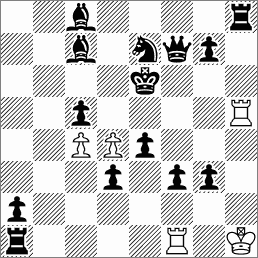 | | h#3 b) Pc4<->Pe4 (5+14) |
Prize for miniature
Dmitry Zhilko (Belarus) |
1) 1.d1=S Rf5 2.Rf3 Rd5 3.Se3 Sc3 #
2) 1.d1=R Sa3 2.Rd5 Sc4 3.Rbd3 Rf4 #
Rich in content miniature with black promotions (it is remarkable that the types of promoted black pieces are the same as the types of thematic white pieces), reciprocally changed functions of Sb1/Rf1, double active self-block and model mates in center of the board. The sequence of black moves is conditioned by anti-critical play of the Black.
| 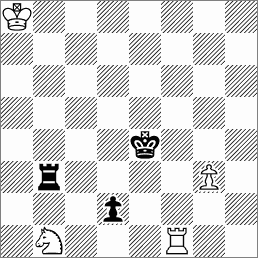 | | h#3 2.1.. (4+3) |
1st Honorable Mention
Anatoly Kirichenko (Russia) |
a) 1.Rf6 Bb7! 2.Kf7 Ra7 3.Qg6 Bd5 #
b) 1.Rf7 Bc6! 2.Qg5 Ra6 3.h5 Be4 #
c) 1.Sh4 Bd5! 2.Kh5 Ra5 3.Sg6 Bf3 #
A good example of author's own older problem improvement (see P1087821). Three model battery echo mates with pinned white pieces. Triple white R+B battery creation with nine Pelle moves. Systematic movement of white pieces attracts very much. Rather harmonious play and admirable Meredith construction. Double change of initial position in ñ) twin (-Rf3, Så8->f3) detracts so much.
| 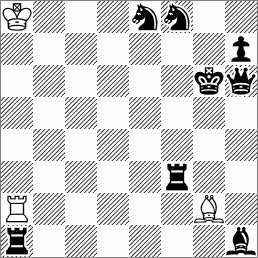 | | h#3 b),c)Se8->g7,f3 (3+8) |
2nd Honorable Mention
Abdelaziz Onkoud (France) |
1) 1.Qh7! B:g4! 2.hg4 Rh8 3.Qh2+ R:h2 #
2) 1.Qc6! R:d3! 2.ed3 Bb7 3.Qg2+ B:g2 #
A complete orthogonal-diagonal analogy of the play in solutions with rich tactical content: gate-opening and anticipatory line-occupation at B1, sacrifice of a white piece (involving active Zilahi) motivated by perspective mate-line opening, ambush play at W2 and bi-colored Bristol with sacrifice of bQ. Abundance of technical black units and quite obvious mates have not allowed to rank this problem higher.
| 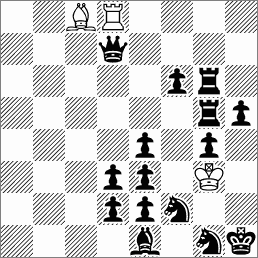 | | h#3 2.1.. (3+15) |
3rd Honorable Mention
N. Kolesnik, R. Zalokotsky
(Ukraine) |
a) 1.Qe2 B:e5+ 2.Kd3 B:b2 3.e3 Rd4 #
1.Qc6 R:e4+ 2.Kc5 Ra4 3.Bd6 Bd4 #
b) 1.Rc3 Bf8 2.Rd3 R:e4+ 3.Kc3 Bb4 #
1.Rc4 Rh3 2.Rb4 B:e5+ 3.Kc4 Rc3 #
Rather interesting HOTF-problem with reciprocally changed functions of Rh5/Bg7 in both pairs of solutions. Mechanism presented in a) has been shown more than once but the 2nd pair combined white ODT with black play known as 'antizielement' seems to be novel. It is a pity that the twin with distant displacement of bQ is technical (cook-stopper). Repeated moves (B:e5+, R:e4+) reduce the judge's evaluation. In the meantime there are similar problems without move repetition (see e.g. P0580272).
| 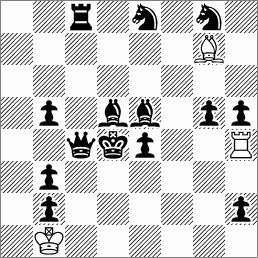 | | h#3 2.1..b)Qc4->h8 (3+14) |
4th Honorable Mention
D. Muller, F. Pachl, R. Wiehagen
(Germany) |
a) 1.Q:g2 Sd4 2.Qa8 Be3 3.Bb7 Sc6#
b) 1.Q:f4 Se5 2.Qa4 R:g5 3.Rb4 Sc4#
Bright and impressive problem with annihilation of a white piece, B+S/R+S direct white battery creation, black Bristol with long moves and model battery mates. Slight imbalance at W1 (gate-opening for bQ only in 'à') is quite acceptable but twinning form with jump of bK seems rather radical. Even in spite of that the problem could won a prize if not partial anticipations with similar play of the Black (see P1071001, P1072517).
| 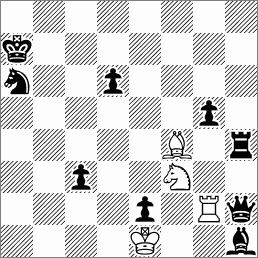 | | h#3 b) Ka7->a5 (4+9) |
5th Honorable Mention
Christer Jonsson (Sweden) |
1) 1.K:e3 Sb4(S:e1?) 2.Qf3(Bf2?) Rd4 3.Bf2 Sc2 #
2) 1.K:d3 Sd1(Êc4?) 2.Qe3(Bd2?) Rc4 3.Bd2 Sb2 #
Rather interesting play with direct self-unpinning and capturing of a white piece at B1 (involving passive Zilahi), dual avoidance at W1 & B2, gate-opening for wR, double active self-block and model chameleon-echo mates in Meredith position.
| 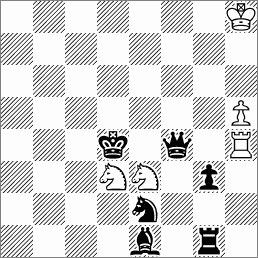 | | h#3 2.1.. (5+6) |
6th Honorable Mention
G.Chumakov, A. & V.Semenenko
(Russia & Ukraine) |
1) 1.Be2 Rd4 2.Bd3 Qa8 3.Be4 Rd7#
2) 1.Rd4 Qe2 2.Rd3 Re8 3.Rf3 Qe7#
A brilliant strategical problem with mutual play on squares e2/d4 at B1/W1, direct/indirect unpinning at B2/B3 with delayed Umnov, reciprocally changed functions of Qf3/Re4 and reciprocal change of roles between Bd1/Rñ4, black ODT with passing through the same square (d3) and model mates. Imbalance in the play of White (gate-opening for wQ at W1 in the 1st solution; Bristol theme - in the 2nd one) is unavoidable in used scheme. The problem could deserve higher distinction if not partial anticipation demonstrating such a brilliant play as the present one (see P0578725).
| 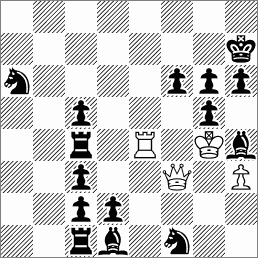 | | h#3 2.1.. (4+15) |
7th Honorable Mention
Borislav Gadjanski (Serbia) |
1) 1.Sd4+ Sd7 2.Kd5 Bb5 3.Ke4 Sf6#
2) 1.Sc6+ Be4 2.Rd8 Sc4 3.Kd7 B:f5#
Tactically saturated combination with indirect checks to wK and distant blocking at B1, creations and play of white half-pins with square vacation for bK, reciprocally changed functions of Sb6/Bd3 and model mates. Compare with P0548465.
However W1 is not equally motivated and B2 is not matched.
|  | | h#3 2.1.. (4+14) |
8th Honorable Mention
Sven Trommler (Germany) |
a) 1.e3 Be8 2.Ke4 Bg6 3.B:f5+ B:f5 #
b) 1.Be3 Rc6 2.Kf4 R:f6 3.Q:f5+ R:f5 #
Not very complex but quite homogeneous play of both sides with Umnov effect, perspective gate-opening for a black piece at W1, white ODT, sacrifice of a black piece at B3 and model mates on the same square with reciprocally changed functions of Bb7/Rñ5. Exchange of bK and bSf3 in twin is justified because the bS eliminates cooks.
|  | | h#3 b) Kd3<->Sf3 (4+10) |
Honorable Mention for miniature
Vadim Vinokurov (Russia) |
a) 1.Rg4 Rd7(Kf7?) 2.Rbf4(Se4?) Kf7 3.Se4 R:d5 #
b) 1.Rf4 Rc7(Ke7?) 2.Rbe4(d4?) Ke7 3.d4 R:c5 #
The familiar mates crown the rather original and harmonious play of both sides in phases. Triple active self-block in combination with black Bristol, reciprocally changed functions of Sc5/Pd5 (involving Chumakov theme) and ideal chameleon-echo mates in minimal miniature. The sequence of moves is conditioned by anti-critical play of both sides. Twinning form (displacement of bK) has reduced the judge's evaluation.
|  | | h#3 b) Kf5->e5 (2+5) |
1st Commendation
Abdelaziz Onkoud (France) |
1) 1.B:f6! f4 2.Kg4 Be8 3.Kf5 Bd7 #
2) 1.S:g6! gh4 2.K:h4 Rf7 3.K:h5 Rh7 #
Passive Zilahi with anticipatory square vacation for bK and distant blocking, reciprocally changed functions of Så5/Bg5, white ODT and pin-mates. Good strategical problem with not quite homogeneous play. Besides the pins are passive and in my view its use is too mechanical.
|  | | h#3 2.1.. (7+7) |
2nd Commendation
N. Kolesnik, À. Mitjushin,
R. Zalokotsky (Ukraine) |
a) diagram 1. ...R:g4 2.Rd4 hg5 3.Rd5 Sc4#
b) Ph4->b4 1. ...B:g4 2.Be6 bc5 3.Bd5 Sd7#
c) Pg4->h4 1. ...Bh3 2.Bg4 Sd7+ 3.Kf5 B:g4#
d)=c) Pg5->f3 1. ...R:h4 2.Rg4 Sc4+ 3.Kf4 R:g4#
Relatively good attempt of a HOTF-problem building by means of integration of two well-known mechanisms (see P1078539 and P1107192). Repeated white moves (Sc4, Sd7) have different roles and are quite justified. Construction is superb but twinning form is far from perfection. The achievement of the authors mostly in technique rather than creativity, however deserves a commendation.
|  | | h#2,5 see text (5+8) |
3rd Commendation
Boris Shorohov (Russia) |
1) 1.K:d4+ Se3 2.d5 f3 3.Be5 S:c2 #
2) 1.K:d5+ Se6 2.Rd4 f4 3.Be4 S:c7 #
One more problem showing captures of wSs (involving passive Zilahi). Total harmony in solutions (self-pinning at W1, Umnov effect with gate-opening at B2 and indirect unpinning with active self-blocking at B3) associates with certain symmetry in the play of both sides which seems to be unavoidable (compare with P0580186). Also the problem contents Chumakov theme, wPf2 double-step and model chameleon-echo mates. The construction is rather heavy but seems optimal for presented content.
| 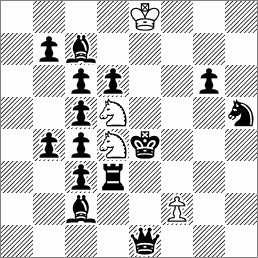 | | h#3 2.1.. (4+14) |
4th Commendation
Harald Grubert (Germany) |
1) 1.Kf4 B:e4(A) 2.Rc5+ Kd4 3.Re2 S:h5(B) #
2) 1.Bc5 S:h5(B) 2.Kf5 K:d5 3.Be2 B:e4(A) #
A double Grimshaw interference has been shown many times (see e.g. P0500570) but in this problem the idea is combined with double square vacation for wK (including bK moves) and reciprocal change of W1/W3 with reciprocally changed functions of Sg3/Bd3. Model mates. The capture of bSd5 is unpleasant.
| 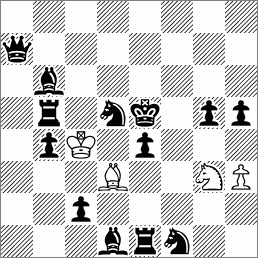 | | h#3 2.1.. (4+13) |
5th Commendation
M. Rimkus, A. Vilkauskas
(Lithuania) |
a) 1. Bf2+ Rb1 2. Kc3 Bd1 3. Bd4 Rb3#
b) 1. Sb4+ Rf3 2. Rd6 Bc6 3. Kc5 Rc3#
Another setting with dynamical creation and play of white half-pins in good construction. It is a pity that wP is needed only in b). There is some lack of harmony in the play of both sides. By the way Dmitry Zhilko - one of the participants of this Memorial - has recently composed a similar problem with more matched play and with best twinning form (see P1182339).
| 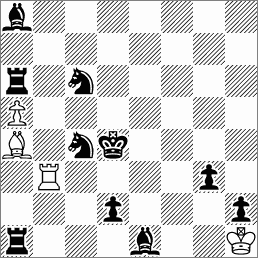 | | h#3 b) Sc4<->Kd4 (4+10) |
6th Commendation
Vladislav Nefyodov (Russia) |
1) 1.Ke6 hg5 2.Bf3! g6 3.Rf5 Rd6 #
2) 1.Kc5 a4 2.Re2! a5 3.Bc4 Bd6 #
Familiar play of the Black contains a nuance at B2 - anticipatory check avoidance by the use of interference of perspective line. White play is dull. The construction is up to the mark! In view of the fact that the White have to move by pawn, the problem with twin (by displacement of wP) in Meredith position would looks better.
| 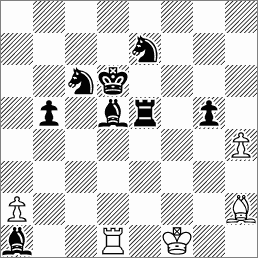 | | h#3 2.1.. (5+8) |
7th Commendation
Jevgeny Fomichev (Russia) |
1) 1. e4 d3 2. ed3 Bc6 3. Qc5 Re4 #
2) 1. Bc5 Bd1 2. Kd5 d4 3. ed4 Bb3 #
A reciprocal change of function between wR/wB in combination with wP double-step has been already shown with more matched and paradoxical play (see P1075395). However the problem has a pep - unexpected sacrifices of wPd2 which is captured by "her black-skinned sister". It is a pity that the other "white-skinner" is needed only in one solution.
|  | | h#3 2.1.. (5+8) |
8th Commendation
A. Pankratyev, M. Gershinsky
(Russia & Ukraine) |
a) 1.Qd7 g4 2.Sf5 gf5 3.Re5 R:d7 #
b) 1.Rb3 f4 2.Se3 fe3 3.Be4 B:b3 #
Rather complex and interesting strategy ending with model diagonal/orthogonal pin-mates in centre of the board. Specified tactical moment (pin) is the only reason to pretend to originality because the rest content of present problem has been realized by C. Jones in a masterful fashion (see P1079359).
| 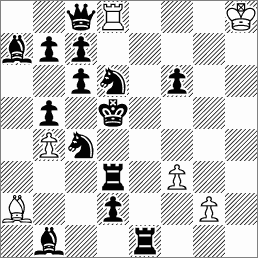 | | h#3 b) Pg2->f2 (6+14) |
9th Commendation
Cheslav Jakubovsky (Belarus) |
1) 1.Qb4 d5 2.Kc5 a3 3.d6 ab #
2) 1.Q:d4 fe 2.Ke5 Ke7 3.Bf5 cd #
3) 1.Qe5 f4 2.Ke6 B:d7+ 3.Kf6 de #
Delayed active sacrifices of bQ (involving Zalokotsky-Ugnivenko theme) with three model mates by wPs. I suppose the problem could won a prize in the first Memorial of V. Kolpakov since mates by pawn were required in theme of that tourney. But in this tourney - against a background of tactically saturated problems - the play of both sides in the present one seems rather simple and dull.
|  | | h#3 3.1.. (6+7) |
10th Commendation
Zoltan Labai (Slovakia) |
1) 1.Qe6 S:c5 2.Bd3 Rb5! 3.Be4 Sd7 #
2) 1.Se4 Sc3 2.Bd6 S:b5 3.Kd5 Sc7 #
By means of unexpected tempo move (Rb5!) the author has shown chameleon-echo battery mates in multi-solution form with transformation of black half-pin to direct R+S white battery by annihilation of one of the two bBs, herewith the other bB blocks a square near bK - reciprocally changed functions of Bb5/Bñ5 in accordance with Chumakov theme.
| 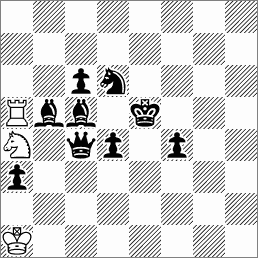 | | h#3 2.1.. (3+9) |
11th Commendation
Sven Trommler (Germany) |
a) 1.Sg8 g4 2.Qf5+ gf5 3.Kh7 f6 #
b) 1.Bf4 g3 2.Kh6 gf4 3.Sg7 f5 #
Relatively simple but rather harmonious play with really cooperative strategy in B+P white battery creation, Umnov effect, wP double-step and model battery chameleon-echo mates. The displacement of the thematic wB in twin b) is a compelled charge per light construction without technical units.
|  | | h#3 b) Bb1->c1 (3+7) |
12th Commendation
V. Nefyodov, N. Kolesnik
(Russia & Ukraine) |
a) 1.Se3 Rg4 2.Sf4 c4+ 3.Ke4 R:f4 #
b) 1.Sf6 Bh2 2.Sg3 e4+ 3.Ke5 B:g3 #
Still popular Maslar theme with reciprocally changed functions of Sf1/Sh5 and model diagonal/orthogonal mates in centre of the board probably in the most economical construction for presented content. Compare with P0577066.
| 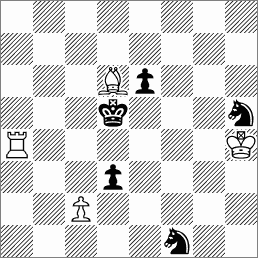 | | h#3 b) Pc2->e2 (4+5) |
13th Commendation
Mihail Gershinsky (Ukraine) |
1) 1.Sf3 e3 2.Kd3 fe8=B 3.K:e4 Bg6 #
2) 1.Bg3 f3 2.Ke3 f8=B 3.Kf4 Bh6 #
It is a rare case of improvement of author's own older problem by means of reduction of solutions (see P1110802). Now the play looks more homogeneous and the construction is perfect for multi-solution form. Pleasant Meredith with distant self-block, square vacation for bK, white B-promotions and model mates.
|  | | h#3 2.1.. (6+5) |
14th Commendation
Valery Kopyl (Ukraine) |
a) 1.Bd3 e7 2.Ke4 e8=S 3.Sñe5 Sd6 #
b) 1.d3 d7 2.Kd4 d8=S 3.Sfe5 Se6 #
A nice Meredith with double Umnov effect in play of the Black, white S-promotions, play by different black pieces on the same squares (d3 & e5), alternative self-block at B3 and model mates in centre of the board.
| 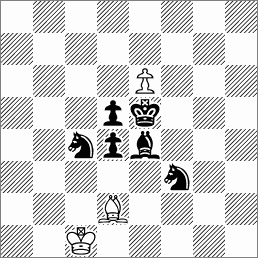 | | h#3 b) Pe6->d6 (3+6) |
Commendation for miniature
Valery Ivanov (Russia) | a) 1.Rc5 Ke7 2.Rd5 Rc4+ 3.Ke5 f4 #
1.Ke4 Ke6 2.Rd4 Rc3 3.f4 f3 #
b) 1.Rc3 Ke7 2.Re3 fe3+ 3.Ke5 Rc5 #
1.e3 Ke7 2.Ke5 fe3 3.Re4 Rc5 #
Four-phased super miniature with ideal mates in center of the board. Epaulette chameleon-echo mates are shown in the 1st pair of solutions with wP double-step. Formally executed in the 2nd pair 'white constant theme' is hardly an achievement. On the other hand reciprocally changed functions of Rñ4/På4 in accordance with Chumakov theme with sacrifices on square e3 and blocking (passive/active) of square e4 is good. Considering of rich play in miniature form one may forgive the repetitions of moves Kå7, Kå5. However a complete anticipation to 1st pair of the solutions (see P1095909) has not allowed to mark the problem with higher distinction. |  | | h#3 2.1.. b) Pf5->e4 (3+3) |
With best wishes to all participants, judge of the tourney Vitaly Medintsev.
Krasnodar, 8 March 2011.
|
